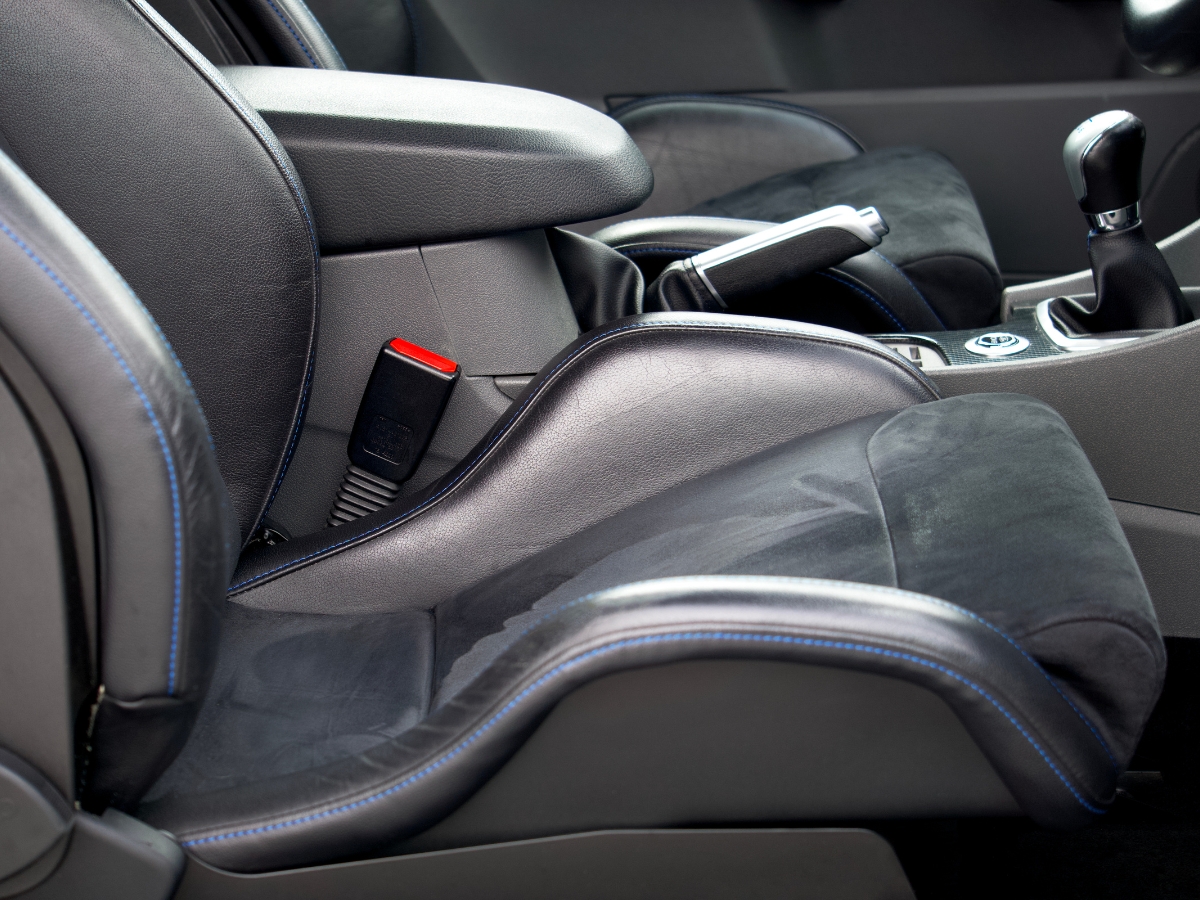Ford’s advanced vehicle comfort technology includes cooled seats, designed for optimal passenger comfort and satisfaction. Cooled seats are a popular amenity in modern cars, providing drivers and passengers comfortable seating temperatures during hot summers or long drives. Ford offers cooling systems in several models, implementing innovative techniques and high-quality components to ensure effective and reliable temperature control.
Understanding the difference between cooled and ventilated seats is key to appreciating Ford’s innovation. While both serve a similar purpose, cooled seats often feature integrated fans or thermoelectric technology for precise temperature management, while ventilated seats primarily focus on air circulation. Ford’s cooling system utilizes thermoelectric devices, ensuring efficient energy usage and environmental responsibility.
Key Takeaways
- Ford’s cooled seats utilize advanced technology for superior comfort in hot climates.
- Cooled seats differ from ventilated seats in their approach to temperature management.
- Thermoelectric devices in Ford’s cooling system contribute to energy efficiency and environmental sustainability.
- Understanding Cooled and Ventilated Seats

Cooled Seats vs Ventilated Seats
Cooled seats function by using built-in fans to circulate air and provide a cooling effect for the seat occupant. They push air through perforated upholstery, reducing the pressure exerted on the lower back and maintaining a comfortable temperature inside the car cabin source. Ventilated seats, on the other hand, also use fans and ducts placed within the seat but solely circulate air without introducing refrigerated air source.
Some key differences between cooled and ventilated seats include:
- Air Temperature: Cooled seats utilize refrigerated air, while ventilated seats circulate ambient air.
- Functionality: Cooled seats focus on cooling the seat material, while ventilated seats aim to enhance airflow primarily for evaporative cooling effects.
- Comfort: Cooled seats are more efficient in maintaining a lowered temperature, offering better relief from heat in comparison to ventilated seats.
Evolution of Seat Cooling Technologies
Over the years, automotive seat cooling technologies have evolved, and brands like Ford have played a significant role in this process. Initially, heated seats were introduced as a comfort feature, providing warmth in cold conditions. With advancements in technology, cooled and ventilated seats were developed to cater to driving in warmer environments.
Some notable milestones in the evolution of seat cooling technologies are:
- Introduction of heated seats: Primarily engineered for colder climates, heated seats use electrical elements to warm up the seat material.
- Development of ventilated seats: Addressing the need for air circulation in seats, carmakers introduced ventilated seats featuring fans and ducts to improve airflow and enhance comfort.
- Incorporation of cooled seats: Realizing the potential for further improvement, the cooled seat was born, combining air circulation with cooling to provide an even more comfortable experience for drivers and passengers.
In conclusion, understanding the differences between cooled seats, ventilated seats, and their evolution helps you make more informed decisions when choosing a vehicle or upgrading your automobile. With continuous advancements in vehicle seat cooling technologies, car manufacturers like Ford strive to provide a comfortable, enjoyable, and customizable driving experience.
Ford’s Cooling System Components
Cooling Elements
Ford’s cooled seats are designed to provide a comfortable and refreshing experience for the driver and passengers. The cooling elements of these seats play a crucial role in achieving this goal. These elements are typically found in the seat cushion and backrest, helping to cool the surface where the occupant’s body comes in contact with the seat. Some air-conditioned car seats use a cooling element similar to that in air conditioners, working on a compression system to provide refrigerated air and enhance the cooling effect1.
Air Circulation
Air circulation is another key component of Ford’s cooled seat system. The seats often feature a porous covering, which allows for your body’s natural cooling system to work even when sitting down1. This porous material facilitates the circulation of air across your skin, carrying away body heat and providing a comfortable experience. Fans in the seat’s base help to pull cool air in and circulate it through the seat’s cushion and backrest, where it eventually exits through the porous covering.
Thermo-Electric Devices
In addition to cooling elements and air circulation, some Ford cooled seats also employ thermo-electric devices to further enhance the cooling effect. These devices, which use electricity to create a temperature difference between their two sides, can effectively “pump” heat away from your body and into the seat’s components. This combination of the cooling element, air circulation, and thermo-electric devices leads to a more energy-efficient and fuel-efficient comfort system1.
By integrating cooling elements, air circulation, and thermo-electric devices, Ford’s cooled seat system provides a more comfortable and pleasant driving experience for its users. These components work together seamlessly to ensure optimal temperature regulation and a refreshing environment inside the vehicle.
Footnotes

Comparison with Other Brands
Acura and Audi
Acura and Audi are two luxury car manufacturers known for offering advanced features, including heated and cooled seats. In Acura models, this feature is generally available in higher trim levels, offering drivers a comfortable ride. Audi, on the other hand, provides heated and cooled seats in various models, depending on the package chosen.
Both Acura and Audi prioritize the use of quality materials and innovative technology to provide a luxurious experience for their drivers. However, it’s worth noting that Ford, a more affordable brand, has managed to incorporate heated and cooled seat technology into its vehicles, providing similar levels of comfort without the luxury price tag.
Hyundai Sonata Limited
The Hyundai Sonata Limited, a popular midsize sedan, also offers heated and cooled seats as part of its upscale package. This trim level adds to the overall comfort of the Sonata by providing a well-ventilated ride, especially during warmer months.
When comparing the Ford cooled seat system with the Hyundai Sonata Limited, it becomes apparent that both brands prioritize passenger comfort. While the specific technologies used in each vehicle may slightly differ, the overall objective of enhancing the driving experience remains consistent.
In summary, while luxury brands like Acura and Audi have long offered heated and cooled seats in their vehicles, more affordable options like Ford and Hyundai Sonata Limited have also embraced this technology. Comparing these brands reveals that each offers its unique approach to adding this convenient feature, ultimately benefiting drivers from a wide range of price points.
Specific Ford Models and Features
Lariat and Platinum
Ford offers ventilated seats in various models, including the Lariat and Platinum trims. These high-end versions of Ford trucks and SUVs, such as the F-150 and the Ford Explorer, come with luxurious features that are designed to enhance the driving experience. Ventilated seats in these trims work by pushing air through tiny perforations in the seat material, providing a cooling effect that keeps passengers comfortable on long drives or during hot summer days.
Heated Rear Seats
Heated rear seats are another feature available in select Ford models. These seats provide warmth during cold weather, ensuring passengers stay comfortable regardless of the temperature outside. The heated rear seats function using a heating element that warms up the seat cushion and backrest. Rear row occupants can typically control the heat intensity through a dedicated button or integrated controls in the vehicle’s infotainment system.
Rear Row
The rear row in Ford vehicles, particularly the larger SUVs, offers ample space to comfortably accommodate adults. In models such as the Ford Explorer and the Expedition, the rear row seating is designed for maximum comfort with ample legroom, headroom, and adjustable settings. When equipped with heated or cooled seats, the rear row becomes an even more pleasant space for passengers to enjoy.
In conclusion, Ford’s commitment to passenger comfort is evident in the numerous features available, including ventilated seats in their Lariat and Platinum trims, heated rear seats, and spacious rear rows. These elements contribute to a superior driving experience for both drivers and passengers alike.
Energy Efficiency and Environmental Impact
Fuel Efficiency
Ford’s cooled seats use a combination of fans, ducts, and in certain cases, refrigerated air to provide comfort to vehicle occupants. When the car’s air conditioning system is utilized for seat cooling, it may lead to a small impact on fuel efficiency. This is because air conditioning systems consume energy derived from the engine’s output. However, the impact on fuel consumption is generally minimal, as modern automotive air conditioning systems are designed to be more efficient and consume less energy.
Refrigerants
Refrigerants play a crucial role in the cooling process of car seats and the air conditioning system in general. Over the years, there have been significant changes in the refrigerants used in automotive cooling systems to minimize their environmental impact. In the past, chlorofluorocarbon (CFC) based refrigerants like Freon were commonly used in vehicles. However, due to concerns related to ozone depletion, safer alternatives such as hydrofluorocarbon (HFC) based compounds like HFC-134a have been introduced.
Regulatory Changes
Environmental standards and regulations have impacted the automotive industry, including seat cooling technologies. One example of such regulatory changes is the phasing out of CFC-based refrigerants in favor of environmentally friendly alternatives. The US Department of Energy (DOE) and the National Renewable Energy Laboratory (NREL) have been actively working to reduce the energy consumption and environmental impact associated with automotive cooling systems, including seat cooling technologies. New regulations and technological advancements are expected to continuously drive improvements in fuel efficiency, refrigerant usage, and overall energy efficiency in vehicles, including those with cooled seats.
Advanced Comfort and Convenience Features
Upholstery and Design
Ford vehicles, especially the higher-end models like the Lariat and Platinum, offer advanced comfort and convenience features. One of the key elements in these vehicles is the use of premium upholstery materials. High-quality leather or mesh upholstery not only lends an air of luxury but also ensures better breathability and support for the driver and passengers.
Driver and Passenger Experience
Air-conditioned seat cushions are an innovative feature that enhances the driver and passenger experience in Ford vehicles. These seats consist of built-in fans that circulate cool air directly to the spots where the occupants are seated. By confining the cooled air to specific areas, these air-conditioned seats use energy more efficiently than traditional air conditioners that cool the entire cabin.
Lane departure warning systems are another great convenience feature. These systems help ensure the safety of the driver by alerting them when the vehicle unintentionally drifts out of the intended lane. Combined with air-conditioned seats and high-quality upholstery, drivers and passengers alike can have a comfortable and enjoyable journey, even in luxury cars where long drives are common.
Below are some notable Ford luxury car models and their key features:
| Model | Upholstery | Air-conditioned Seats | Lane Departure Warning |
|---|---|---|---|
| Ford Lariat | Leather or Mesh | Yes, built-in fans | Yes |
| Ford Platinum | Leather or Mesh | Yes, built-in fans | Yes |
Advanced comfort and convenience features such as air-conditioned seat cushions, lane departure warning systems, and top-quality upholstery go a long way in enhancing the driver and passenger experience in Ford vehicles. Investing in models like the Lariat and Platinum ensures that you will be able to enjoy the luxurious comfort and convenience that Ford has to offer.
The Future of Cooled Seats in Ford Vehicles
Ford is continuously working on enhancing the comfort and convenience of their vehicles. One of these innovations is the introduction of automatic heated and cooled seats in a range of their models. To understand the significance of this development, let’s delve into how cooled seats work and their potential impact on Ford’s lineup of trucks and SUVs.
Cooled seats function by circulating air through perforations in the seat’s surface. This air movement helps to dissipate heat and moisture, providing a more comfortable driving experience, especially in warmer climates or during long trips. The implementation of this technology in Ford’s vehicles will cater to the increasing demand for enhanced comfort in both trucks and SUVs.
Ford’s trucks, such as the popular F-150 series, are well-known for their towing capabilities. As drivers often spend extended periods in their vehicles while towing, the integration of cooled seats could prove highly beneficial. Drivers who previously faced discomfort due to heat and humidity during towing will appreciate this added feature that enhances comfort during their journey.
Similarly, Ford’s SUV lineup includes models like the Explorer and Expedition, which are designed for family-friendly versatility and off-road adventures. Like trucks, these SUVs are expected to provide a comfortable experience for the occupants. The addition of cooled seats in these models would ensure an enjoyable ride even in warmer conditions and during extended trips.
In summary, the incorporation of cooled seats in Ford’s future trucks and SUVs will be a welcome enhancement, improving the overall driving experience for their customers. As the automotive landscape continues to evolve, innovations like these are evidence of Ford’s commitment to ensuring their vehicles offer a comfortable, convenient, and enjoyable ride for drivers and passengers alike.
Frequently Asked Questions
How do Ford’s cooled seats function?
Ford’s cooled seats work through a process called thermoelectric cooling. This method relies on electric cooling devices, which transfer heat energy away from the seating surface, thereby providing a cooler seat for the occupant.
What is the difference between ventilated and cooled seats?
While cooled seats specifically focus on lowering the seat temperature using thermoelectric cooling, ventilated seats circulate air within the seat to help maintain a comfortable temperature. Ventilated seats primarily promote airflow, removing excess heat and moisture, whereas cooled seats actively cool down the seating surfaces.
What are the pros and cons of Ford’s ventilated seats?
The primary advantage of ventilated seats is that they help maintain a comfortable temperature in both hot and cold climates, reducing sweating and discomfort. Additionally, they can be more energy-efficient compared to traditional air conditioning systems. However, one downside is that their effectiveness can vary depending on the exterior temperature and user sensitivity to temperature changes.
Which Ford models offer cooled seats?
Many Ford models provide the option for cooled seats, including the F-150, Fusion, Explorer, and the Mustang. It’s essential to check the specific trim levels and options to verify cooled seats’ availability in a particular Ford vehicle.
Is it possible to install a cooled seats kit in a Ford vehicle?
While some aftermarket seat cooling kits are available, compatibility can vary depending on the specific make and model of the Ford vehicle. It is essential to contact a professional car customization shop to determine the feasibility and ensure proper installation.
Do heated and cooled seats in a Ford impact fuel consumption?
Heated and cooled seats in a Ford vehicle generally have a minimal impact on fuel consumption. While these systems do draw power, it is much lower compared to the vehicle’s overall energy consumption. Additionally, cooled seats can be more energy-efficient than traditional air conditioning systems, as they cool the occupant directly instead of cooling the entire cabin.




